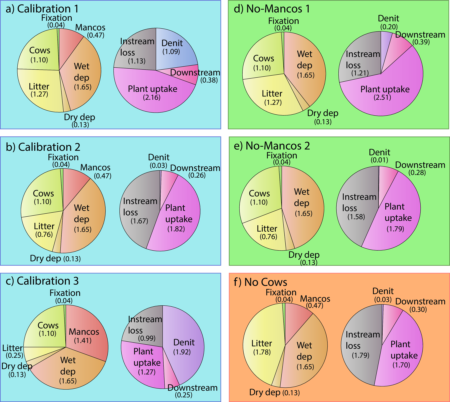
Proportional breakdown of average annual sources (left pie in each panel) and sinks, or “fates” (right pie in each panel) for the entire ERW for each of the three calibration scenarios (C1-C3), two no-Mancos scenarios (NM1-NM2), and the no cow (NC) scenario.
We developed a semi-distributed, watershed-scale ensemble of models to quantify the sources, transformations, and sinks of geogenic and atmospheric nitrogen within a mountain watershed. This hydrobiogeochemical model determines nitrogen (N) export fluxes from terrestrial systems as a function of hydrology. In this way, the biogeochemical cycling of N relative to its loss through transport is determined as a continuum of subsurface water residence times. This represents a particularly novel approach to modeling nutrient cycling, one which is capable of rapidly scaling from hillslope to watershed to basin. In the current study, the model is used to predict the importance of different sources, including the weathering of N-rich shale bedrock, and sinks for N at the watershed scale. In particular, we highlight the critical role of vegetation in the retention and release of nitrogen (Maavara et al., 2021).
We developed a so-called High-Altitude Nitrogen Suite of Models (HAN-SoMo), a watershed-scale ensemble of process-based models to quantify the relative sources, transformations, and sinks of geogenic and atmospheric N through the East River watershed. This model predicts nitrogen fluxes across bedrock-to-canopy compartments, terrestrial to aquatic interfaces, and watershed-scale hydrobiogeochemical gradients as a function of subsurface water residence times through coupling to the PARFLOW model.
Summary
At the watershed scale, bedrock weathering accounted for ~21% of new N-sources (Fig. 1), which was an important albeit smaller contribution than that derived from atmospheric deposition. On an annual scale, removal of dissolved N through in stream processes (i.e., denitrification and export), plant turnover, and atmospheric deposition are the most important controls on N cycling (Maavara et al., 2021). We are currently using this model to evaluate how terrestrial N cycling pathways change under two emergent climate change scenarios: warming and wildfire. Warming significantly changes montane hydrology, including evapotranspiration, which feeds back on to subsurface water residence times and biogeochemical cycling. This model is currently being used to explore the impacts of climate warming and wildfire on downstream nitrogen exports.
Citation
Maavara T, Siirila-Woodburn ER, Maina F, Maxwell RM, Sample JE, Chadwick KD, Carroll R, Newcomer ME, Dong W, Williams KH, Steefel CI, Bouskill NJ (2021) Modeling geogenic and atmospheric nitrogen through the East River Watershed, Colorado Rocky Mountains. PLoS One. doi.org/10.1371/journal.pone.0247907
